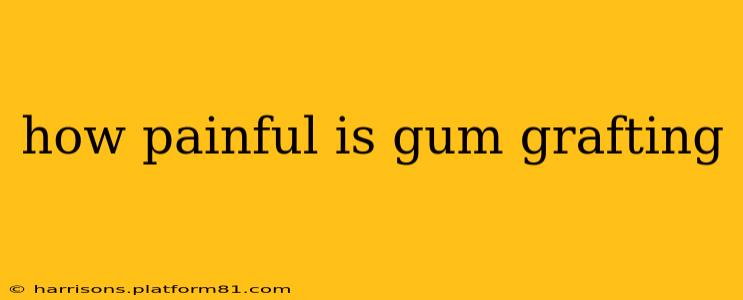Gum grafting, a common periodontal procedure, can sound daunting. The question on many minds is: how painful is it? The truth is, the experience varies significantly depending on several factors, including the type of graft used, the extent of the procedure, your individual pain tolerance, and your dentist's skill and aftercare recommendations. This guide will explore the pain levels involved, addressing common concerns and providing valuable insights.
What is Gum Grafting?
Before diving into pain levels, let's briefly understand the procedure. Gum grafting is a surgical procedure designed to address gum recession, where the gum tissue pulls back, exposing the tooth roots and making them vulnerable to decay, sensitivity, and bone loss. Several techniques exist, each with its nuances. The goal is to regenerate gum tissue, covering the exposed roots and restoring the protective barrier.
How Painful is Gum Grafting During the Procedure?
Most patients report minimal to moderate discomfort during the procedure itself. This is because your dentist will administer local anesthesia to numb the affected area completely. You might feel some pressure or tugging, but you shouldn't feel sharp pain. The experience is often described as similar to having a filling done. However, the level of discomfort can vary slightly depending on the complexity of the surgery and the individual's sensitivity.
What About Pain After the Procedure?
The pain after the procedure is where the experience becomes more subjective. Immediately following the procedure, you'll likely experience some numbness, which gradually wears off. Once the numbness subsides, you can anticipate some degree of discomfort, ranging from mild soreness to moderate pain. This is generally managed effectively with prescribed pain medication, such as ibuprofen or stronger options if needed. The intensity and duration of post-operative pain differ from person to person.
How Long Does the Pain Last?
The pain usually peaks within the first 24-48 hours after the surgery and then gradually diminishes over the next few days. Most patients report significantly reduced pain within a week. However, some mild soreness or discomfort might linger for a couple of weeks.
What Factors Influence Post-Operative Pain?
Several factors influence the intensity and duration of post-operative pain:
- Type of graft: Different grafting techniques may lead to varying levels of post-operative discomfort.
- Extent of the procedure: Larger grafts naturally involve more tissue manipulation and may lead to more pain.
- Individual pain tolerance: Personal thresholds for pain vary significantly.
- Aftercare: Diligent adherence to your dentist's post-operative instructions is crucial in minimizing pain and complications. This includes proper medication use, maintaining oral hygiene, and avoiding irritating foods.
- Dentist's skill and experience: A skilled and experienced periodontist will perform the procedure with precision, minimizing trauma and thus reducing post-operative pain.
What Can I Do to Manage Post-Operative Pain?
Your dentist will provide detailed post-operative instructions, likely including:
- Prescription pain medication: This will help to manage more intense pain.
- Over-the-counter pain relievers: Ibuprofen or acetaminophen can help with milder pain.
- Ice packs: Applying ice packs to the affected area can help reduce swelling and inflammation, thereby reducing pain.
- Gentle rinsing: Rinsing your mouth gently with salt water can aid in healing and reduce discomfort.
- Soft food diet: Sticking to a soft food diet avoids putting undue pressure or irritation on the surgical site.
Is Gum Grafting a Major Surgery?
No, gum grafting is generally considered a minor surgical procedure. However, like any surgical procedure, it carries potential risks and complications, though these are rare. It's crucial to discuss any concerns with your dentist before undergoing the procedure.
How Much Does Gum Grafting Cost?
The cost of gum grafting varies depending on several factors, including the extent of the procedure, the type of graft used, and your geographical location. It's best to contact your dentist or periodontist for a personalized cost estimate.
What are the Alternatives to Gum Grafting?
While gum grafting is a highly effective solution for gum recession, alternative treatments may be considered in certain cases. These options should be discussed with your dentist to determine the most appropriate approach for your individual needs.
Remember, this information is for general knowledge and does not substitute professional advice. Consult with your dentist or periodontist to discuss your specific situation and concerns before undergoing any dental procedure. They can accurately assess your individual risk factors and provide personalized guidance.
